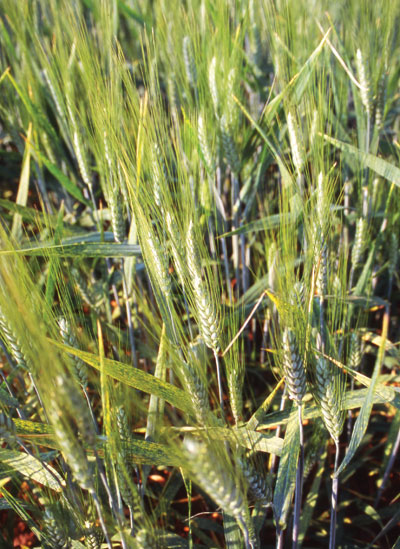
Features
Agronomy
Plant Breeding
Getting to the heart of durum wheat physiology
“Although new genetic tools and technology provide important advancements in breeding work, understanding why certain lines have a better balance between higher yield and better quality is necessary,” explains Dr. Hong Wang, research scientist with Agriculture and Agri-Food Canada (AAFC) in Swift Current.
February 24, 2010 By Donna Fleury
Finding out what makes durum wheat tick will help balance high yield, improved grain protein, and quality in new durum wheat cultivar development.
“Although new genetic tools and technology provide important advancements in breeding work, understanding why certain lines have a better balance between higher yield and better quality is necessary,” explains Dr. Hong Wang, research scientist with Agriculture and Agri-Food Canada (AAFC) in Swift Current. “Most of my research is focused on physiology, which is an important basis for breeding work. The resulting co-operation between physiology and plant breeding in selecting the best lines is very important.”

|
|
| Sorting out the physiology of durum will help improve varieties Advertisement
|
Wang is working closely with AAFC plant breeders, Dr. Asheesh Singh and Dr. Ron DePauw on developing new traits for durum wheat. Previously, Wang also worked extensively with Dr. John Clarke, who is now retired from AAFC. Plant breeding takes years, and it is a continual progress of improving traits such as yield, quality and protein, and other factors such as disease resistance and improved straw standability. “One of the challenges of developing new cultivars is keeping the balance between yield, protein and quality,” explains Wang. “There is a negative relationship between yield and protein, so if you target higher yields, then generally the protein is lower and the quality is poorer. This is why breeding is so difficult, and why we have to use different relationships so we can achieve both higher yields and improved quality and protein.”
About 10 years ago, Wang and colleagues initiated the first durum physiology research project to compare Canadian Western Amber Durum (CWAD) cultivars released at different times in terms of yield components, dry matter production and N uptake and remobilization. “We worked with two different types of cultivars in the study, semi-dwarf cultivars such as AC Navigator and conventional tall cultivars such as AC Avonlea,” says Wang. “Newer cultivars have been developed, but they continue to follow these two main types, which gives us a good comparison for different physiological aspects.”
Wang’s research showed that the two types of cultivars have different physiological approaches to increasing yield while maintaining grain protein concentration. AC Navigator, a semi-dwarf cultivar, achieved higher yield through increased kernel weight and spikes per plant. AC Avonlea, a conventional height cultivar, significantly increased spike size through increasing both kernel weight and kernels per spike. Of the cultivars, AC Avonlea had the highest N use efficiency, which could be related to its large spike size.
In comparing the two types of cultivars, semi-dwarf varieties tend to be higher yielding and can be grown in better environments with higher fertility and irrigation without lodging. These varieties also have a high N harvest index, which is the ratio of grain yield to total biomass. Tall cultivars tend to be suited to relatively poorer growing environments and have a lower N harvest index. “However, tall cultivars have a higher potential to remobilize nutrients from the stem and leaves to the grain, which improves the potential for increasing yield and protein, even if plants are stressed,” says Wang. “Unlike tall cultivars that have this ability to remobilize N, semi-dwarf varieties require additional N to be provided to improve protein.”
Researchers are continuing to take the best of these two types of cultivars and develop more alternatives depending on the growing area and the type of soil. Offering growers more alternatives or choices improves production stability and reduces the potential for losses from drought conditions, too much rain or other factors. Some of the newer cultivars with these improvements include Commander, a new generation of AC Navigator, and Strongfield, a new generation of AC Avonlea with higher yields and better quality. Cultivar development for biofuels and climate change More recently, Wang’s research has focused on assessing potential opportunities for developing traits suited for biofuel production and addressing potential challenges from climate change. The research is focused on developing cultivars that would have higher grain yields for ethanol production for example, but also maintain high quality in the residue or straw for biofuel uses. These new cultivars would contribute to both the grain component and residue components for various uses. “We’re also assessing cultivars for suitability to climate change, where warmer conditions and the potential for more precipitation in the spring are expected,” explains Wang. “This may allow durum to be grown in more northerly parts of Western Canada, which could create new challenges for diseases and factors such as day length, to which some cultivars are very sensitive. Under these conditions, breeding may include cultivars with longer maturity, which would increase potential yield but also the challenge of keeping higher quality.”
Researchers continue to build on this platform of durum varieties to move towards a balance of high yield, high protein and good quality cultivars. This collaboration between plant breeding and physiology enhances the understanding and selection of the best tools and approaches to achieve the targeted traits and cultivars.